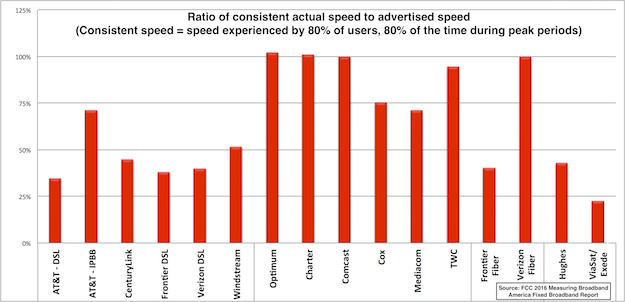
Cable modem service is reliable and fast, and getting faster, but DSL service offered by telcos isn’t. That’s the top line conclusion of the Federal Communications Commission’s 2016 annual report on fixed broadband service across the U.S…
When DSL is used to provide broadband service, the maximum advertised download speeds among the most popular service tiers has increased only slightly since 2011. In contrast, for cable services, the maximum advertised download speeds among the most popular service tiers have increased from 12-30 Mbps in March 2011 to 100-300 Mbps in September 2015.
The increase in cable’s advertised speed is attributed to upgrades from DOCSIS 2 to DOCSIS 3 technology. Cable is also better at delivering advertised speeds…
For subscribers to DSL-based broadband service, the increase in median download speeds has varied among ISPs, with most ISPs showing little or no change. For subscribers to each of the participating cable broadband services, there have been fairly steady and substantial increases in median download speeds…The actual speeds experienced by most ISPs’ subscribers are close to or exceed the advertised speeds. However, DSL broadband ISPs continue to advertise “up-to” speeds that on average exceed the actual speeds experienced by their subscribers.
When consistency of performance is factored in, the difference between DSL and cable modem service is even starker. The chart above shows the difference between advertised speeds and what a user can expect can expect to get consistently (i.e. what 80% of the users tested experienced 80% of the time during peak periods). The actual, consistent speed delivered by most telcos is less than half the advertised speed.
The exceptions are Windstream, which is right around 50% and AT&T’s Uverse service, which delivers advertised speeds consistently about 70% of the time. But AT&T’s legacy DSL is the worst of them all, with actual speed only 35% of advertised. AT&T lobbied the FCC to report those two types of service separately. If AT&T’s overall performance was averaged, it would be in the same range as the rest.
The report also notes falling performance figures for satellite Internet service, which it attributes to increased congestion as more users jump on to limited capacity satellites, and relatively flat results for fiber-based service.
